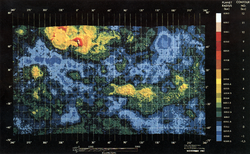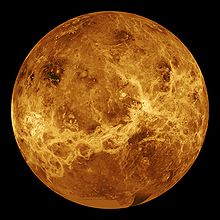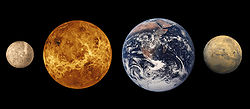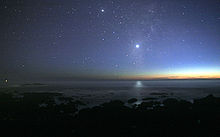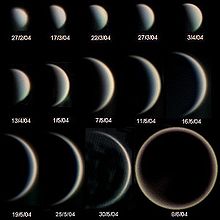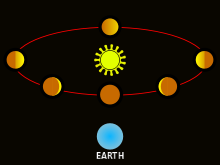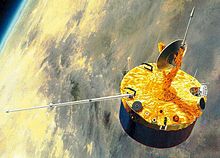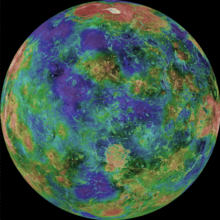- Venus
-
Venus 
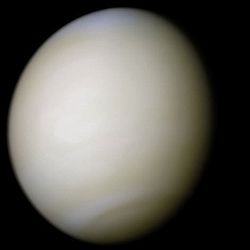 Venus in real color. The surface is obscured by a thick blanket of clouds.Designations
Venus in real color. The surface is obscured by a thick blanket of clouds.DesignationsPronunciation  i/ˈviːnəs/
i/ˈviːnəs/Adjective Venusian or (rarely) Cytherean, Venerean Epoch J2000 Aphelion 108,942,109 km
0.728 231 28 AUPerihelion 107,476,259 km
0.718 432 70 AUSemi-major axis 108,208,930 km
0.723 332 AUEccentricity 0.006 8 Orbital period 224.700 69 day
0.615 197 0 yr
1.92 Venus solar daySynodic period 583.92 days[1] Average orbital speed 35.02 km/s Mean anomaly 50.44675° Inclination 3.394 71° to Ecliptic
3.86° to Sun’s equator
2.19° to Invariable plane[2]Longitude of ascending node 76.670 69° Argument of perihelion 54.852 29° Satellites None Physical characteristicsMean radius 6,051.8 ± 1.0 km[3]
0.949 9 EarthsFlattening 0[3] Surface area 4.60×108 km2
0.902 EarthsVolume 9.38×1011 km3
0.857 EarthsMass 4.868 5×1024 kg
0.815 EarthsMean density 5.204 g/cm3 Equatorial surface gravity 8.87 m/s2
0.904 gEscape velocity 10.46 km/s Sidereal rotation
period−243.018 5 day Equatorial rotation velocity 6.52 km/h (1.81 m/s) Axial tilt 177.3°[1] North pole right ascension 18 h 11 min 2 s
272.76°[4]North pole declination 67.16° Albedo 0.67 (geometric)[5]
0.90 (Bond)[5]Surface temp.
Kelvin
Celsiusmin mean max 735 K[1][9][10] 460 °C Apparent magnitude brightest −4.9[6][7] (crescent)
−3.8[8] (full)Angular diameter 9.7"–66.0"[1] AtmosphereSurface pressure 93 bar (9.3 MPa) Composition ~96.5% carbon dioxide
~3.5% nitrogen
0.015% sulfur dioxide
0.007% argon
0.002% water vapor
0.001 7% carbon monoxide
0.001 2% helium
0.000 7% neon
trace carbonyl sulfide
trace hydrogen chloride
trace hydrogen fluorideVenus is the second planet from the Sun, orbiting it every 224.7 Earth days.[9] The planet is named after Venus, the Roman goddess of love and beauty. After the Moon, it is the brightest natural object in the night sky, reaching an apparent magnitude of −4.6, bright enough to cast shadows. Because Venus is an inferior planet from Earth, it never appears to venture far from the Sun: its elongation reaches a maximum of 47.8°. Venus reaches its maximum brightness shortly before sunrise or shortly after sunset, for which reason it has been known as the Morning Star or Evening Star.
Venus is classified as a terrestrial planet and it is sometimes called Earth's "sister planet" due to the similar size, gravity, and bulk composition. Venus is covered with an opaque layer of highly reflective clouds of sulfuric acid, preventing its surface from being seen from space in visible light. Venus has the densest atmosphere of all the terrestrial planets in the Solar System, consisting mostly of carbon dioxide. Venus has no carbon cycle to lock carbon back into rocks and surface features, nor does it seem to have any organic life to absorb it in biomass. Venus is believed to have previously possessed Earth-like oceans,[11] but these evaporated as the temperature rose. Venus's surface is a dusty dry desertscape with many slab-like rocks, periodically refreshed by volcanism. The water has most likely dissociated, and, because of the lack of a planetary magnetic field, the hydrogen has been swept into interplanetary space by the solar wind.[12] The atmospheric pressure at the planet's surface is 92 times that of the Earth.
The Venusian surface was a subject of speculation until some of its secrets were revealed by planetary science in the twentieth century. It was finally mapped in detail by Project Magellan in 1990–91. The ground shows evidence of extensive volcanism, and the sulfur in the atmosphere may indicate that there have been some recent eruptions.[13][14] The absence of evidence of lava flow accompanying any of the visible caldera remains an enigma. The planet has few impact craters, demonstrating that the surface is relatively young, approximately 300–600 million years old.[15][16] There is no evidence for plate tectonics, possibly because its crust is too strong to subduct without water to make it less viscous. Instead, Venus may lose its internal heat in periodic major resurfacing events.[15]
Contents
Physical characteristics
Venus is one of the four solar terrestrial planets, meaning that, like the Earth, it is a rocky body. In size and mass, it is very similar to the Earth, and is often described as Earth's "sister" or "twin".[17] The diameter of Venus is only 650 km less than the Earth's, and its mass is 81.5% of the Earth's. Conditions on the Venusian surface differ radically from those on Earth, due to its dense carbon dioxide atmosphere. The mass of the atmosphere of Venus is 96.5% carbon dioxide, with most of the remaining 3.5% being nitrogen.[18]
Internal structure
Without seismic data or knowledge of its moment of inertia, there is little direct information about the internal structure and geochemistry of Venus.[19] The similarity in size and density between Venus and Earth suggests that they share a similar internal structure: a core, mantle, and crust. Like that of Earth, the Venusian core is at least partially liquid because the two planets have been cooling at about the same rate.[20] The slightly smaller size of Venus suggests that pressures are significantly lower in its deep interior than Earth. The principal difference between the two planets is the lack of plate tectonics on Venus, likely due to the dry surface and mantle. This results in reduced heat loss from the planet, preventing it from cooling and providing a likely explanation for its lack of an internally generated magnetic field.[21]
Geography
About 80% of the Venusian surface is covered by smooth volcanic plains, consisting of 70% plains with wrinkle ridges and 10% smooth or lobate plains.[22] Two highland "continents" make up the rest of its surface area, one lying in the planet's northern hemisphere and the other just south of the equator. The northern continent is called Ishtar Terra, after Ishtar, the Babylonian goddess of love, and is about the size of Australia. Maxwell Montes, the highest mountain on Venus, lies on Ishtar Terra. Its peak is 11 km above the Venusian average surface elevation. The southern continent is called Aphrodite Terra, after the Greek goddess of love, and is the larger of the two highland regions at roughly the size of South America. A network of fractures and faults covers much of this area.[23]
As well as the impact craters, mountains, and valleys commonly found on rocky planets, Venus has a number of unique surface features. Among these are flat-topped volcanic features called farra, which look somewhat like pancakes and range in size from 20–50 km across, and 100–1,000 m high; radial, star-like fracture systems called novae; features with both radial and concentric fractures resembling spider webs, known as arachnoids; and coronae, circular rings of fractures sometimes surrounded by a depression. These features are volcanic in origin.[24]
Most Venusian surface features are named after historical and mythological women.[25] Exceptions are Maxwell Montes, named after James Clerk Maxwell, and highland regions Alpha Regio, Beta Regio and Ovda Regio. The former three features were named before the current system was adopted by the International Astronomical Union, the body that oversees planetary nomenclature.[26]
The longitudes of physical features on Venus are expressed relative to its prime meridian. The original prime meridian passed through the radar-bright spot at the center of the oval feature Eve, located south of Alpha Regio.[27] After the Venera missions were completed, the prime meridian was redefined to pass through the central peak in the crater Ariadne.[28][29]
Surface geology
Much of the Venusian surface appears to have been shaped by volcanic activity. Venus has several times as many volcanoes as Earth, and it possesses some 167 large volcanoes that are over 100 km across. The only volcanic complex of this size on Earth is the Big Island of Hawaii.[24] This is not because Venus is more volcanically active than Earth, but because its crust is older. Earth's oceanic crust is continually recycled by subduction at the boundaries of tectonic plates, and has an average age of about 100 million years,[30] while the Venusian surface is estimated to be 300–600 million years old.[15][24]
Several lines of evidence point to ongoing volcanic activity on Venus. During the Soviet Venera program, the Venera 11 and Venera 12 probes detected a constant stream of lightning, and Venera 12 recorded a powerful clap of thunder soon after it landed. The European Space Agency's Venus Express recorded abundant lightning in the high atmosphere.[31] While rainfall drives thunderstorms on Earth, there is no rainfall on the surface of Venus (though it does rain sulfuric acid in the upper atmosphere that evaporates around 25 km above the surface). One possibility is that ash from a volcanic eruption was generating the lightning. Another piece of evidence comes from measurements of sulfur dioxide concentrations in the atmosphere, which were found to drop by a factor of 10 between 1978 and 1986. This may imply that the levels had earlier been boosted by a large volcanic eruption.[32]
There are almost a thousand impact craters on Venus evenly distributed across its surface. On other cratered bodies, such as the Earth and the Moon, craters show a range of states of degradation. On the Moon, degradation is caused by subsequent impacts, while on Earth, it is caused by wind and rain erosion. On Venus, about 85% of craters are in pristine condition. The number of craters, together with their well-preserved condition, indicates that the planet underwent a global resurfacing event about 300–600 million years ago,[15][16] followed by a decay in volcanism.[33] Earth's crust is in continuous motion, but it is thought that Venus cannot sustain such a process. Without plate tectonics to dissipate heat from its mantle, Venus instead undergoes a cyclical process in which mantle temperatures rise until they reach a critical level that weakens the crust. Then, over a period of about 100 million years, subduction occurs on an enormous scale, completely recycling the crust.[24]
Venusian craters range from 3 km to 280 km in diameter. There are no craters smaller than 3 km, because of the effects of the dense atmosphere on incoming objects. Objects with less than a certain kinetic energy are slowed down so much by the atmosphere that they do not create an impact crater.[34] Incoming projectiles less than 50 meters in diameter will fragment and burn up in the atmosphere before reaching the ground.[35]
Atmosphere and climate
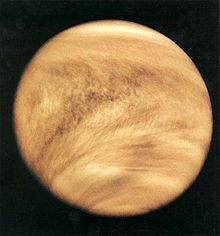 Cloud structure in the Venusian atmosphere in 1979, revealed by ultraviolet observations by Pioneer Venus Orbiter
Cloud structure in the Venusian atmosphere in 1979, revealed by ultraviolet observations by Pioneer Venus Orbiter
Venus has an extremely dense atmosphere, which consists mainly of carbon dioxide and a small amount of nitrogen. The atmospheric mass is 93 times that of Earth's atmosphere while the pressure at the planet's surface is about 92 times that at Earth's surface—a pressure equivalent to that at a depth of nearly 1 kilometer under Earth's oceans. The density at the surface is 65 kg/m³ (6.5% that of water). The CO2-rich atmosphere, along with thick clouds of sulfur dioxide, generates the strongest greenhouse effect in the Solar System, creating surface temperatures of over 460 °C (860 °F).[36] This makes the Venusian surface hotter than Mercury's which has a minimum surface temperature of −220 °C and maximum surface temperature of 420 °C,[37] even though Venus is nearly twice Mercury's distance from the Sun and thus receives only 25% of Mercury's solar irradiance. The surface of Venus is often said to resemble Hell.[38]
Studies have suggested that several billion years ago the Venusian atmosphere was much more like Earth's than it is now, and that there were probably substantial quantities of liquid water on the surface, but a runaway greenhouse effect was caused by the evaporation of that original water, which generated a critical level of greenhouse gases in its atmosphere.[39]
Thermal inertia and the transfer of heat by winds in the lower atmosphere mean that the temperature of the Venusian surface does not vary significantly between the night and day sides, despite the planet's extremely slow rotation. Winds at the surface are slow, moving at a few kilometers per hour, but because of the high density of the atmosphere at the Venusian surface, they exert a significant amount of force against obstructions, and transport dust and small stones across the surface. This alone would make it difficult for a human to walk through, even if the heat and lack of oxygen were not a problem.[40]
Above the dense CO2 layer are thick clouds consisting mainly of sulfur dioxide and sulfuric acid droplets.[41][42] These clouds reflect about 60% of the sunlight that falls on them back into space, and prevent the direct observation of the Venusian surface in visible light. The permanent cloud cover means that although Venus is closer than Earth to the Sun, the Venusian surface is not as well lit. Strong 300 km/h winds at the cloud tops circle the planet about every four to five earth days.[43] Venusian winds move at up to 60 times the speed of the planet's rotation, while Earth's fastest winds are only 10% to 20% rotation speed.[44]
The surface of Venus is effectively isothermal; it retains a constant temperature not only between day and night but between the equator and the poles.[1][45] The planet's minute axial tilt (less than three degrees, compared with 23 degrees for Earth), also minimizes seasonal temperature variation.[46] The only appreciable variation in temperature occurs with altitude. In 1995, the Magellan probe imaged a highly reflective substance at the tops of the highest mountain peaks which bore a strong resemblance to terrestrial snow. This substance arguably formed from a similar process to snow, albeit at a far higher temperature. Too volatile to condense on the surface, it rose in gas form to cooler higher elevations, where it then fell as precipitation. The identity of this substance is not known with certainty, but speculation has ranged from elemental tellurium to lead sulfide (galena).[47]
The clouds of Venus are capable of producing lightning much like the clouds on Earth.[48] The existence of lightning had been controversial since the first suspected bursts were detected by the Soviet Venera probes. In 2006–07 Venus Express clearly detected whistler mode waves, the signatures of lightning. Their intermittent appearance indicates a pattern associated with weather activity. The lightning rate is at least half of that on Earth.[48] In 2007 the Venus Express probe discovered that a huge double atmospheric vortex exists at the south pole of the planet.[49][50]
Magnetic field and core
In 1967, Venera-4 found that the Venusian magnetic field is much weaker than that of Earth. This magnetic field is induced by an interaction between the ionosphere and the solar wind,[51][52] rather than by an internal dynamo in the core like the one inside the Earth. Venus' small induced magnetosphere provides negligible protection to the atmosphere against cosmic radiation. This radiation may result in cloud-to-cloud lightning discharges.[53]
The lack of an intrinsic magnetic field at Venus was surprising given that it is similar to Earth in size, and was expected also to contain a dynamo at its core. A dynamo requires three things: a conducting liquid, rotation, and convection. The core is thought to be electrically conductive and, while its rotation is often thought to be too slow, simulations show that it is adequate to produce a dynamo.[54][55] This implies that the dynamo is missing because of a lack of convection in the Venusian core. On Earth, convection occurs in the liquid outer layer of the core because the bottom of the liquid layer is much hotter than the top. On Venus, a global resurfacing event may have shut down plate tectonics and led to a reduced heat flux through the crust. This caused the mantle temperature to increase, thereby reducing the heat flux out of the core. As a result, there is not an internal geodynamo that can drive a magnetic field. Instead the heat energy from the core is being used to reheat the crust.[56]
One possibility is that Venus has no solid inner core,[57] or its core is not currently cooling, so that the entire liquid part of the core is at approximately the same temperature. Another possibility is that its core has already completely solidified. The state of the core is highly dependent on the concentration of sulfur, which is unknown at present.[56]
Orbit and rotation
 Venus orbits the Sun at an average distance of about 108 million kilometers (about 0.7 AU), and completes an orbit every 224.65 days. Venus is the second planet from the Sun and it revolves round the Sun approximately 1.6 times (yellow trail) in Earth's 365 days (blue trail)
Venus orbits the Sun at an average distance of about 108 million kilometers (about 0.7 AU), and completes an orbit every 224.65 days. Venus is the second planet from the Sun and it revolves round the Sun approximately 1.6 times (yellow trail) in Earth's 365 days (blue trail)
 The orbital position and rotation of Venus shown at 10 Earth-day intervals from 0 to 250 days. The position of the point of the surface that was the antisolar point at day zero is indicated by a cross. As a consequence of its slow retrograde rotation, any given point on Venus has nearly 60 terrestrial days of continuous illumination and an equivalent period of darkness.
The orbital position and rotation of Venus shown at 10 Earth-day intervals from 0 to 250 days. The position of the point of the surface that was the antisolar point at day zero is indicated by a cross. As a consequence of its slow retrograde rotation, any given point on Venus has nearly 60 terrestrial days of continuous illumination and an equivalent period of darkness.
Venus orbits the Sun at an average distance of about 108 million kilometers (about 0.7 AU), and completes an orbit every 224.65 days. Although all planetary orbits are elliptical, Venus is the closest to circular, with an eccentricity of less than 0.01.[1] When Venus lies between the Earth and the Sun, a position known as "inferior conjunction", it makes the closest approach to Earth of any planet, lying at an average distance of 41 million km during inferior conjunction.[1] The planet reaches inferior conjunction every 584 days, on average.[1] Due to the decreasing eccentricity of Earth, the minimum distances will become greater. From the year 1 to 5383, there are 526 approaches less than 40 million km; then there are none for about 60,200 years.[58] During periods of greater eccentricity Venus can come as close as 38.2 million km.[1]
All the planets of the Solar System orbit in a counter-clockwise direction as viewed from above the Sun's north pole: most planets also rotate counter-clockwise but Venus rotates clockwise (called "retrograde" rotation) once every 243 Earth days—by far the slowest rotation period of any major planet. The equator of the Venusian surface rotates at 6.5 km/h while on Earth rotation speed at the equator is about 1,670 km/h.[59] A Venusian sidereal day thus lasts longer than a Venusian year (243 versus 224.7 Earth days). Because of the retrograde rotation the length of a solar day on Venus is significantly shorter than the sidereal day. As a result of Venus's relatively long solar day, one Venusian year is about 1.92 Venusian days long.[10] To an observer on the surface of Venus the Sun would appear to rise in the west and set in the east and the time from one sunrise to the next would be 116.75 Earth days (making the Venusian solar day shorter than Mercury's 176 Earth days).[10]
Venus may have formed from the solar nebula with a different rotation period and obliquity, reaching to its current state because of chaotic spin changes caused by planetary perturbations and tidal effects on its dense atmosphere, a change that would have occurred over the course of billions of years. The rotation period of Venus may represent an equilibrium state between tidal locking to the Sun's gravitation, which tends to slow rotation, and an atmospheric tide created by solar heating of the thick Venusian atmosphere.[60][61] A curious aspect of the Venusian orbit and rotation periods is that the 584-day average interval between successive close approaches to the Earth is almost exactly equal to five Venusian solar days. Whether this relationship arose by chance or is the result of tidal locking with the Earth is unknown.[62]
Venus currently has no natural satellite,[63] though the asteroid 2002 VE68 presently maintains a quasi-orbital relationship with it.[64] In the 17th century Giovanni Cassini reported a moon orbiting Venus which was named Neith and there were numerous reported sightings over the following 200 years but it was ultimately determined that most were stars in the vicinity. Alex Alemi's and David Stevenson's 2006 study of models of the early Solar System at the California Institute of Technology shows that it is likely that billions of years ago Venus had at least one moon created by a huge impact event.[65][66] About 10 million years later, according to the study, another impact reversed the planet's spin direction and caused the Venusian moon gradually to spiral inward[67] until it collided and merged with Venus. If later impacts created moons these also were absorbed in the same way. An alternative explanation for the lack of satellites is the effect of strong solar tides, which can destabilize large satellites orbiting the inner terrestrial planets.[63]
Observation
Venus is always brighter than any star. The greatest luminosity, apparent magnitude −4.9,[7] occurs during crescent phase when it is near the Earth. Venus fades to about magnitude -3 when it is backlit by the Sun.[6] The planet is bright enough to be seen in the middle of the day when the sky is very clear[68], and the planet can be easy to see when the Sun is low on the horizon. As an inferior planet, it always lies within about 47° of the Sun.[8]
Venus "overtakes" the Earth every 584 days as it orbits the Sun.[1] As it does so, it changes from the "Evening star", visible after sunset, to the "Morning star", visible before sunrise. While Mercury, the other inferior planet, reaches a maximum elongation of only 28° and is often difficult to discern in twilight, Venus is hard to miss when it is at its brightest. Its greater maximum elongation means it is visible in dark skies long after sunset. As the brightest point-like object in the sky, Venus is a commonly misreported "unidentified flying object". U.S. President Jimmy Carter reported having seen a UFO in 1969, which later analysis suggested was probably the planet. Countless other people have mistaken Venus for something more exotic.[69]
As it moves around its orbit, Venus displays phases in a telescopic view like those of the Moon: In the phases of Venus the planet presents a small "full" image when it is on the opposite side of the Sun. It shows a larger "quarter phase" when it is at its maximum elongations from the Sun. Venus is at its brightest in the night sky and presents a much larger "thin crescent" in telescopic views as it comes around to the near side between the Earth and the Sun. Venus is at its largest and presents its "new phase" when it is between the Earth and the Sun. Since it has an atmosphere it can be seen in a telescope by the halo of light refracted around the planet.[8]
The Venusian orbit is slightly inclined relative to the Earth's orbit; thus, when the planet passes between the Earth and the Sun, it usually does not cross the face of the Sun. Transits of Venus do occur when the planet's inferior conjunction coincides with its presence in the plane of the Earth's orbit. Transits of Venus occur in cycles of 243 years with the current pattern of transits being pairs of transits separated by eight years, at intervals of about 105.5 years or 121.5 years. The most recent transit was in June 2004; the next will be in June 2012. The preceding pair of transits occurred in December 1874 and December 1882; the following pair will occur in December 2117 and December 2125.[70] Historically, transits of Venus were important, because they allowed astronomers to directly determine the size of the astronomical unit, and hence the size of the Solar System. Captain Cook's exploration of the east coast of Australia came after he had sailed to Tahiti in 1768 to observe a transit of Venus.[71][72]
A long-standing mystery of Venus observations is the so-called Ashen light—an apparent weak illumination of the dark side of the planet, seen when the planet is in the crescent phase. The first claimed observation of ashen light was made as long ago as 1643, but the existence of the illumination has never been reliably confirmed. Observers have speculated that it may result from electrical activity in the Venusian atmosphere, but it may be illusory, resulting from the physiological effect of observing a very bright crescent-shaped object.[73]
Studies
Early studies
 The Venus tablet of Ammisaduqa, dated 1581 BC, records the observations of Babylonian astrologers. It refers to Venus as Nin-dar-an-na, or "bright queen of the sky".
The Venus tablet of Ammisaduqa, dated 1581 BC, records the observations of Babylonian astrologers. It refers to Venus as Nin-dar-an-na, or "bright queen of the sky".
Venus was known to ancient civilizations both as the "morning star" and as the "evening star", names that reflect the early understanding that these were two separate objects. The Venus tablet of Ammisaduqa, dated 1581 BC, shows that the Babylonians understood that the two were a single object, referred to in the tablet as the "bright queen of the sky," and could support this view with detailed observations.[74] The Greeks thought of the two as separate stars, Phosphorus and Hesperus, until the time of Pythagoras in the sixth century BC.[75] The Romans designated the morning aspect of Venus as Lucifer, literally "Light-Bringer", and the evening aspect as Vesper.
The transit of Venus was first observed in 1032 by the Persian astronomer Avicenna, who concluded that Venus is closer to the Earth than the Sun,[76] and established that Venus was, at least sometimes, below the Sun.[77] In the 12th century, the Andalusian astronomer Ibn Bajjah observed "two planets as black spots on the face of the Sun," which was later identified as the transit of Venus and Mercury by the Maragha astronomer Qotb al-Din Shirazi in the 13th century.[78]
When the Italian physicist Galileo Galilei first observed the planet in the early 17th century, he found that it showed phases like the Moon, varying from crescent to gibbous to full and vice versa. When Venus is furthest from the Sun in the sky it shows a half-lit phase and when it is closest to the Sun in the sky it shows as a crescent or full phase. This could be possible only if Venus orbited the Sun, and this was among the first observations to clearly contradict the Ptolemaic geocentric model that the Solar System was concentric and centered on the Earth.[79]
The atmosphere of Venus was discovered in 1761 by Russian polymath Mikhail Lomonosov.[80][81] Venus' atmosphere was observed in 1790 by German astronomer Johann Schröter. Schröter found that when the planet was a thin crescent, the cusps extended through more than 180°. He correctly surmised that this was due to scattering of sunlight in a dense atmosphere. Later, American astronomer Chester Smith Lyman observed a complete ring around the dark side of the planet when it was at inferior conjunction, providing further evidence for an atmosphere.[82] The atmosphere complicated efforts to determine a rotation period for the planet, and observers such as Italian-born astronomer Giovanni Cassini and Schröter incorrectly estimated periods of about 24 hours from the motions of markings on the planet's apparent surface.[83]
Ground-based research
Little more was discovered about Venus until the 20th century. Its almost featureless disc gave no hint what its surface might be like, and it was only with the development of spectroscopic, radar and ultraviolet observations that more of its secrets were revealed. The first UV observations were carried out in the 1920s, when Frank E. Ross found that UV photographs revealed considerable detail that was absent in visible and infrared radiation. He suggested that this was due to a very dense yellow lower atmosphere with high cirrus clouds above it.[84]
Spectroscopic observations in the 1900s gave the first clues about the Venusian rotation. Vesto Slipher tried to measure the Doppler shift of light from Venus, but found that he could not detect any rotation. He surmised that the planet must have a much longer rotation period than had previously been thought.[85] Later work in the 1950s showed that the rotation was retrograde. Radar observations of Venus were first carried out in the 1960s, and provided the first measurements of the rotation period which were close to the modern value.[86]
Radar observations in the 1970s revealed details of the Venusian surface for the first time. Pulses of radio waves were beamed at the planet using the 300 m radio telescope at Arecibo Observatory, and the echoes revealed two highly reflective regions, designated the Alpha and Beta regions. The observations also revealed a bright region attributed to mountains, which was called Maxwell Montes.[87] These three features are now the only ones on Venus which do not have female names.[88]
Exploration
Early efforts
The first robotic space probe mission to Venus, and the first to any planet, began on February 12, 1961 with the launch of the Venera 1 probe. The first craft of the otherwise highly successful Soviet Venera program, Venera 1 was launched on a direct impact trajectory, but contact was lost seven days into the mission, when the probe was about 2 million km from Earth. It was estimated to have passed within 100,000 km from Venus in mid-May.[89]
The United States exploration of Venus also started badly with the loss of the Mariner 1 probe on launch. The subsequent Mariner 2 mission enjoyed greater success, and after a 109-day transfer orbit on December 14, 1962 it became the world's first successful interplanetary mission, passing 34,833 km above the surface of Venus. Its microwave and infrared radiometers revealed that while the Venusian cloud tops were cool, the surface was extremely hot—at least 425 °C, finally ending any hopes that the planet might harbor ground-based life. Mariner 2 also obtained improved estimates of its mass and of the astronomical unit, but was unable to detect either a magnetic field or radiation belts.[90]
Atmospheric entry
The Soviet Venera 3 probe crash-landed on Venus on March 1, 1966. It was the first man-made object to enter the atmosphere and strike the surface of another planet, though its communication system failed before it was able to return any planetary data.[91] Venus's next encounter with an unmanned probe came on October 18, 1967 when Venera 4 successfully entered the atmosphere and deployed a number of science experiments. Venera 4 showed that the surface temperature was even hotter than Mariner 2 had measured at almost 500 °C, and that the atmosphere was about 90 to 95% carbon dioxide. The Venusian atmosphere was considerably denser than Venera 4's designers had anticipated, and its slower than intended parachute descent meant that its batteries ran down before the probe reached the surface. After returning descent data for 93 minutes, Venera 4's last pressure reading was 18 bar at an altitude of 24.96 km.[91]
Another probe arrived at Venus one day later on October 19, 1967 when Mariner 5 conducted a flyby at a distance of less than 4000 km above the cloud tops. Mariner 5 was originally built as backup for the Mars-bound Mariner 4, but when that mission was successful, the probe was refitted for a Venus mission. A suite of instruments more sensitive than those on Mariner 2, in particular its radio occultation experiment, returned data on the composition, pressure and density of the Venusian atmosphere.[92] The joint Venera 4–Mariner 5 data were analyzed by a combined Soviet-American science team in a series of colloquia over the following year,[93] in an early example of space cooperation.[94]
Armed with the lessons and data learned from Venera 4, the Soviet Union launched the twin probes Venera 5 and Venera 6 five days apart in January 1969; they encountered Venus a day apart on May 16 and May 17 that year. The probes were strengthened to improve their crush depth to 25 bar and were equipped with smaller parachutes to achieve a faster descent. Since then-current atmospheric models of Venus suggested a surface pressure of between 75 and 100 bar, neither was expected to survive to the surface. After returning atmospheric data for a little over fifty minutes, they both were crushed at altitudes of approximately 20 km before going on to strike the surface on the night side of Venus.[91]
Surface and atmospheric science
Venera 7 represented an effort to return data from the planet's surface, and was constructed with a reinforced descent module capable of withstanding a pressure of 180 bar. The module was pre-cooled before entry and equipped with a specially reefed parachute for a rapid 35-minute descent. Entering the atmosphere on December 15, 1970, the parachute is believed to have partially torn during the descent, and the probe struck the surface with a hard, yet not fatal, impact. Probably tilted onto its side, it returned a weak signal supplying temperature data for 23 minutes, the first telemetry received from the surface of another planet.[91]
The Venera program continued with Venera 8 sending data from the surface for 50 minutes, after entering the atmosphere on July 22, 1972. Venera 9, which entered the atmosphere of Venus on October 22, 1975, and Venera 10, which entered the atmosphere three days later on October 25, sent the first images of the Venusian landscape. The two landing sites presented very different terrain in the immediate vicinities of the landers: Venera 9 had landed on a 20 degree slope scattered with boulders around 30–40 cm across; Venera 10 showed basalt-like rock slabs interspersed with weathered material.[95]
In the meantime, the United States had sent the Mariner 10 probe on a gravitational slingshot trajectory past Venus on its way to Mercury. On February 5, 1974, Mariner 10 passed within 5790 km of Venus, returning over 4000 photographs as it did so. The images, the best then achieved, showed the planet to be almost featureless in visible light, but ultraviolet light revealed details in the clouds that had never been seen in Earth-bound observations.[96]
The American Pioneer Venus project consisted of two separate missions.[97] The Pioneer Venus Orbiter was inserted into an elliptical orbit around Venus on December 4, 1978, and remained there for over thirteen years studying the atmosphere and mapping the surface with radar. The Pioneer Venus Multiprobe released a total of four probes which entered the atmosphere on December 9, 1978, returning data on its composition, winds and heat fluxes.[98]
Four more Venera lander missions took place over the next four years, with Venera 11 and Venera 12 detecting Venusian electrical storms;[99] and Venera 13 and Venera 14, landing four days apart on March 1 and March 5, 1982, returning the first color photographs of the surface. All four missions deployed parachutes for braking in the upper atmosphere, but released them at altitudes of 50 km, the dense lower atmosphere providing enough friction to allow for an unaided soft landing. Both Venera 13 and 14 analyzed soil samples with an on-board X-ray fluorescence spectrometer, and attempted to measure the compressibility of the soil with an impact probe.[99] Venera 14, though, had the misfortune to strike its own ejected camera lens cap and its probe failed to contact the soil.[99] The Venera program came to a close in October 1983 when Venera 15 and Venera 16 were placed in orbit to conduct mapping of the Venusian terrain with synthetic aperture radar.[100]
In 1985 the Soviet Union took advantage of the opportunity to combine missions to Venus and Comet Halley, which passed through the inner Solar System that year. En route to Halley, on June 11 and June 15, 1985 the two spacecraft of the Vega program each dropped a Venera-style probe (of which Vega 1's partially failed) and released a balloon-supported aerobot into the upper atmosphere. The balloons achieved an equilibrium altitude of around 53 km, where pressure and temperature are comparable to those at Earth's surface. They remained operational for around 46 hours, and discovered that the Venusian atmosphere was more turbulent than previously believed, and subject to high winds and powerful convection cells.[101][102]
Radar mapping
The United States' Magellan probe was launched on May 4, 1989 with a mission to map the surface of Venus with radar.[26] The high-resolution images it obtained during its 4½ years of operation far surpassed all prior maps and were comparable to visible-light photographs of other planets. Magellan imaged over 98% of the Venusian surface by radar[103] and mapped 95% of its gravity field. In 1994, at the end of its mission, Magellan was deliberately sent to its destruction into the atmosphere of Venus to quantify its density.[104] Venus was observed by the Galileo and Cassini spacecraft during flybys on their respective missions to the outer planets, but Magellan would otherwise be the last dedicated mission to Venus for over a decade.[105][106]
Current and future missions
NASA's MESSENGER mission to Mercury performed two flybys of Venus in October 2006 and June 2007, to slow its trajectory for an eventual orbital insertion of Mercury in March 2011. MESSENGER collected scientific data on both those flybys.[107]
The Venus Express probe was designed and built by the European Space Agency. Launched on November 9, 2005 by a Russian Soyuz-Fregat rocket procured through Starsem, it successfully assumed a polar orbit around Venus on April 11, 2006.[108] The probe is undertaking a detailed study of the Venusian atmosphere and clouds, including mapping of the planet's plasma environment and surface characteristics, particularly temperatures. One of the first results emerging from Venus Express is the discovery that a huge double atmospheric vortex exists at the south pole of the planet.[108]
The Japan Aerospace Exploration Agency (JAXA) devised a Venus orbiter, Akatsuki (formerly "Planet-C"), which was launched on May 20, 2010 but the craft failed to enter orbit in December 2010. Hopes remain that the probe can successfully hibernate and make another insertion attempt in six years. Planned investigations included surface imaging with an infrared camera and experiments designed to confirm the presence of lightning as well as the determination of the existence of current surface volcanism.[110]
The European Space Agency (ESA) hopes to launch a mission to Mercury in 2014, called BepiColombo, which will perform two flybys of Venus before it reaches Mercury orbit in 2020.[111]
Under its New Frontiers Program, NASA has proposed a lander mission called the Venus In-Situ Explorer to land on Venus to study surface conditions and investigate the elemental and mineralogical features of the regolith. The probe would be equipped with a core sampler to drill into the surface and study pristine rock samples not weathered by the very harsh surface conditions. The Venera-D (Russian: Венера-Д) probe is a proposed Russian space probe to Venus, to be launched around 2016 with its goal to make remote-sensing observations around the planet Venus and deploying a lander, based on the Venera design, capable of surviving for a long duration on the planet's surface. Other proposed Venus exploration concepts include rovers, balloons, and airplanes.[112]
NASA has recommended the Surface and Atmosphere Geochemical Explorer (SAGE) candidate mission to land on Venus, with a possible launch in 2016.[113]
Manned flyby
A manned Venus flyby mission, using Apollo program hardware, was proposed in the late 1960s.[114] The mission was planned to launch in late October or early November 1973, and would have used a Saturn V to send three men to fly past Venus in a flight lasting approximately one year. The spacecraft would have passed approximately 5,000 kilometres from the surface of Venus about four months later.[114]
Timeline
This is a list of attempted and successful spacecraft that have left Earth to explore Venus more closely.[115] Venus has also been imaged by the Hubble Space Telescope in Earth orbit, and distant telescopic observations is another source of information about Venus.
- Timeline by NASA Goddard Space Flight Center (up to 2011)[115]
Responsible Mission Launch Elements and Result Notes USSR 
Sputnik 7 February 4, 1961 Impact (attempted) USSR 
Venera 1 February 12, 1961 Flyby (contact lost) USA 
Mariner 1 July 22, 1962 Flyby (launch failure) USSR 
Sputnik 19 August 25, 1962 Flyby (attempted) USA 
Mariner 2 August 27, 1962 Flyby USSR 
Sputnik 20 September 1, 1962 Flyby (attempted) USSR 
Sputnik 21 September 12, 1962 Flyby (attempted) USSR 
Cosmos 21 November 11, 1963 Attempted Venera test flight? USSR 
Venera 1964A February 19, 1964 Flyby (launch failure) USSR 
Venera 1964B March 1, 1964 Flyby (launch failure) USSR 
Cosmos 27 March 27, 1964 Flyby (attempted) USSR 
Zond 1 April 2, 1964 Flyby (contact lost) USSR 
Venera 2 November 12, 1965 Flyby (contact lost) USSR 
Venera 3 November 16, 1965 Lander (contact lost) USSR 
Cosmos 96 November 23, 1965 Lander (attempted?) USSR 
Venera 1965A November 23, 1965 Flyby (launch failure) USSR 
Venera 4 June 12, 1967 Probe USA 
Mariner 5 June 14, 1967 Flyby USSR 
Cosmos 167 June 17, 1967 Probe (attempted) USSR 
Venera 5 January 5, 1969 Probe USSR 
Venera 6 January 10, 1969 Probe USSR 
Venera 7 August 17, 1970 Lander USSR 
Cosmos 359 August 22, 1970 Probe (attempted) USSR 
Venera 8 March 27, 1972 Probe USSR 
Cosmos 482 March 31, 1972 Probe (attempted) USA 
Mariner 10 November 4, 1973 Flyby Mercury flyby USSR 
Venera 9 June 8, 1975 Orbiter and lander USSR 
Venera 10 June 14, 1975 Orbiter and lander USA 
Pioneer Venus 1 May 20, 1978 Orbiter USA 
Pioneer Venus 2 August 8, 1978 Probes USSR 
Venera 11 September 9, 1978 Flyby bus and lander USSR 
Venera 12 September 14, 1978 Flyby bus and lander USSR 
Venera 13 October 30, 1981 Flyby bus and lander USSR 
Venera 14 November 4, 1981 Flyby bus and lander USSR 
Venera 15 June 2, 1983 Orbiter USSR 
Venera 16 June 7, 1983 Orbiter USSR 
Vega 1 December 15, 1984 Lander and balloon Comet Halley flyby USSR 
Vega 2 December 21, 1984 Lander and balloon Comet Halley flyby USA 
Magellan May 4, 1989 Orbiter USA 
Galileo October 18, 1989 Flyby Jupiter orbiter/probe USA 
Cassini October 15, 1997 Flyby Saturn orbiter USA 
MESSENGER August 3, 2004 Flyby (x2) Mercury orbiter ESA Venus Express November 9, 2005 Orbiter JPN 
Akatsuki December 7, 2010 Orbiter (attempted) Possible reattempt in 2016 ESA
JPN
BepiColombo July 2014 Flyby (x2, Planned) Planned Mercury orbiter In culture
The adjective Venusian is commonly used for items related to Venus, though the Latin adjective is the rarely used Venerean; the archaic Cytherean is still occasionally encountered. Venus is the only planet in the Solar System that is named after a female figure.[a] (Three dwarf planets – Ceres, Eris and Haumea – along with many of the first discovered asteroids[116] and a number of moons (such as the Galilean moons) also have feminine names. Earth and its moon also have feminine names in many languages – Gaia/Terra, Selene/Luna – but the female mythological figures who personified them were named after them, not the other way around.)[117]
Historic understanding
As one of the brightest objects in the sky, Venus has been known since prehistoric times and as such has gained an entrenched position in human culture. It is described in Babylonian cuneiformic texts such as the Venus tablet of Ammisaduqa, which relates observations that possibly date from 1600 BC.[118] The Babylonians named the planet Ishtar (Sumerian Inanna), the personification of womanhood, and goddess of love.[119]
The Ancient Egyptians believed Venus to be two separate bodies and knew the morning star as Tioumoutiri and the evening star as Ouaiti.[120] Likewise, believing Venus to be two bodies, the Ancient Greeks called the morning star Φωσφόρος, Phosphoros (Latinized Phosphorus), the "Bringer of Light" or Ἐωσφόρος, Eosphoros (Latinized Eosphorus), the "Bringer of Dawn". The evening star they called Hesperos (Latinized Hesperus) (Ἓσπερος, the "star of the evening"). By Hellenistic times, the ancient Greeks realized the two were the same planet,[121][122] which they named after their goddess of love, Aphrodite (Phoenician Astarte).[123] Hesperos would be translated into Latin as Vesper and Phosphoros as Lucifer ("Light Bearer"), a poetic term later used to refer to the fallen angel cast out of heaven.[b] The Romans, who derived much of their religious pantheon from the Greek tradition, named the planet Venus after their goddess of love.[124] Pliny the Elder (Natural History, ii,37) identified the planet Venus with Isis.[125]
In Iranian mythology, especially in Persian mythology, the planet usually corresponds to the goddess Anahita. In some parts of Pahlavi literature the deities Aredvi Sura and Anahita are regarded as separate entities, the first one as a personification of the mythical river and the latter as a goddess of fertility which is associated with the planet Venus. As the goddess Aredvi Sura Anahita—and simply called Anahita as well—both deities are unified in other descriptions, e. g. in the Greater Bundahishn, and are represented by the planet. In the Avestan text Mehr Yasht (Yasht 10) there is a possible early link to Mithra. The Persian name of the planet today is "Nahid" which derives from Anahita and later in history from the Pahlavi language Anahid.[126][127][128][129]
The planet Venus was important to the Maya civilization, who developed a religious calendar based in part upon its motions, and held the motions of Venus to determine the propitious time for events such as war. They named it Noh Ek', the Great Star, and Xux Ek', the Wasp Star. The Maya were aware of the planet's synodic period, and could compute it to within a hundredth part of a day.[130]
The Maasai people named the planet Kileken, and have an oral tradition about it called The Orphan Boy.[131]
Venus is important in many Australian aboriginal cultures, such as that of the Yolngu people in Northern Australia. The Yolngu gather after sunset to await the rising of Venus, which they call Barnumbirr. As she approaches, in the early hours before dawn, she draws behind her a rope of light attached to the Earth, and along this rope, with the aid of a richly decorated "Morning Star Pole", the people are able to communicate with their dead loved ones, showing that they still love and remember them. Barnumbirr is also an important creator-spirit in the Dreaming, and "sang" much of the country into life.[132]
Venus plays a prominent role in Pawnee mythology. The Pawnee, a North American native tribe, until as late as 1838, practiced a morning star ritual in which a girl was sacrificed to the morning star.[133]
In western astrology, derived from its historical connotation with goddesses of femininity and love, Venus is held to influence desire and sexual fertility.[134] In Indian Vedic astrology, Venus is known as Shukra,[135] meaning "clear, pure" or "brightness, clearness" in Sanskrit. One of the nine Navagraha, it is held to affect wealth, pleasure and reproduction; it was the son of Bhrgu, preceptor of the Daityas, and guru of the Asuras.[136] Modern Chinese, Korean, Japanese and Vietnamese[citation needed] cultures refer to the planet literally as the “metal star” (金星), based on the Five elements.[137]
In the metaphysical system of Theosophy, it is believed that on the etheric plane of Venus there is a civilization that existed hundreds of millions of years before Earth’s[138] and it is also believed that the governing deity of Earth, Sanat Kumara, is from Venus.[139]
The astronomical symbol for Venus is the same as that used in biology for the female sex: a circle with a small cross beneath.[140] The Venus symbol also represents femininity, and in Western alchemy stood for the metal copper.[140] Polished copper has been used for mirrors from antiquity, and the symbol for Venus has sometimes been understood to stand for the mirror of the goddess.[140]
Perhaps the strangest appearance of Venus in literature is as the harbinger of destruction in Immanuel Velikovsky's Worlds in Collision (1950). In this intensely controversial book, Velikovsky argued that many seemingly unbelievable stories in the Old Testament are true recollections of times when Venus nearly collided with the Earth — when it was still a comet and had not yet become the docile planet that we know today. He contended that Venus caused most of the strange events of the Exodus. He cites legends in many other cultures (such as Greek, Mexican, Chinese and Indian) indicating that the effects of the near-collision were global. The scientific community rejected his wildly unorthodox book, but it became a bestseller.[141]
In science fiction
The impenetrable Venusian cloud cover gave science fiction writers free rein to speculate on conditions at its surface; all the more so when early observations showed that not only was it very similar in size to Earth, it possessed a substantial atmosphere. Closer to the Sun than Earth, the planet was frequently depicted as warmer, but still habitable by humans.[142] The genre reached its peak between the 1930s and 1950s, at a time when science had revealed some aspects of Venus, but not yet the harsh reality of its surface conditions. Findings from the first missions to Venus showed the reality to be very different, and brought this particular genre to an end.[143] As scientific knowledge of Venus advanced, so science fiction authors endeavored to keep pace, particularly by conjecturing human attempts to terraform Venus.[144]
Colonization
Due to its extremely hostile conditions, a surface colony on Venus is out of the question with current technology. The atmospheric pressure and temperature approximately fifty kilometres above the surface are similar to those at the Earth's surface and Earth air (nitrogen and oxygen) would be a lifting gas in the Venusian atmosphere of mostly carbon dioxide. This has led to proposals for extensive "floating cities" in the Venusian atmosphere.[145] Aerostats (lighter-than-air balloons) could be used for initial exploration and ultimately for permanent settlements.[145] Among the many engineering challenges are the dangerous amounts of sulfuric acid at these heights.[145]
Namesakes
USS Venus (AK-135) was a United States Navy Crater class cargo ship named after the planet.
See also
Notes
References
- ^ a b c d e f g h i j Williams, David R. (April 15, 2005). "Venus Fact Sheet". NASA. http://nssdc.gsfc.nasa.gov/planetary/factsheet/venusfact.html. Retrieved 2007-10-12.
- ^ "The MeanPlane (Invariable plane) of the Solar System passing through the barycenter". 2009-04-03. http://home.comcast.net/~kpheider/MeanPlane.gif. Retrieved 2009-04-10. (produced with Solex 10 written by Aldo Vitagliano; see also Invariable plane)
- ^ a b Seidelmann, P. Kenneth; Archinal, B. A.; A’hearn, M. F.; et al. (2007). "Report of the IAU/IAGWorking Group on cartographic coordinates and rotational elements: 2006". Celestial Mechanics and Dynamical Astronomy 90 (3): 155–180. Bibcode 2007CeMDA..98..155S. doi:10.1007/s10569-007-9072-y. http://adsabs.harvard.edu/doi/10.1007/s10569-007-9072-y. Retrieved 2007-08-28.
- ^ "Report on the IAU/IAG Working Group on cartographic coordinates and rotational elements of the planets and satellites". International Astronomical Union. 2000. http://www.hnsky.org/iau-iag.htm. Retrieved 2007-04-12.
- ^ a b Mallama, A.; Wang, D.; Howard, R.A. (2006). "Venus phase function and forward scattering from H2SO4". Icarus 182 (1): 10–22. Bibcode 2006Icar..182...10M. doi:10.1016/j.icarus.2005.12.014.
- ^ a b Mallama, A. (2011). "Planetary magnitudes". Sky and Telescope 121(1): 51–56.
- ^ a b "HORIZONS Web-Interface for Venus (Major Body=299)". JPL Horizons On-Line Ephemeris System. 2006-Feb-27 (GEOPHYSICAL DATA). http://ssd.jpl.nasa.gov/horizons.cgi?find_body=1&body_group=mb&sstr=299. Retrieved 2010-11-28. (Using JPL Horizons you can see that on 2013-Dec-08 Venus will have an apmag of -4.89)
- ^ a b c Espenak, Fred (1996). "Venus: Twelve year planetary ephemeris, 1995–2006". NASA Reference Publication 1349. NASA/Goddard Space Flight Center. http://eclipse.gsfc.nasa.gov/TYPE/venus2.html#ve2006. Retrieved 2006-06-20.
- ^ a b "Venus: Facts & Figures". NASA. http://sse.jpl.nasa.gov/planets/profile.cfm?Object=Venus&Display=Facts&System=Metric. Retrieved 2007-04-12.
- ^ a b c "Space Topics: Compare the Planets: Mercury, Venus, Earth, The Moon, and Mars". Planetary Society. http://www.planetary.org/explore/topics/compare_the_planets/terrestrial.html. Retrieved 2007-04-12.
- ^ Hashimoto, G. L.; Roos-Serote, M.; Sugita, S.; Gilmore, M. S.; Kamp, L. W.; Carlson, R. W.; Baines, K. H. (2008). "Felsic highland crust on Venus suggested by Galileo Near-Infrared Mapping Spectrometer data". Journal of Geophysical Research, Planets 113: E00B24. Bibcode 2008JGRE..11300B24H. doi:10.1029/2008JE003134.
- ^ "Caught in the wind from the Sun". ESA (Venus Express). 2007-11-28. http://www.esa.int/SPECIALS/Venus_Express/SEM0G373R8F_0.html. Retrieved 2008-07-12.
- ^ Esposito, Larry W. (1984-03-09). "Sulfur Dioxide: Episodic Injection Shows Evidence for Active Venus Volcanism". Science 223 (4640): 1072–1074. Bibcode 1984Sci...223.1072E. doi:10.1126/science.223.4640.1072. PMID 17830154. http://www.sciencemag.org/cgi/content/abstract/223/4640/1072. Retrieved 2009-04-29.
- ^ Bullock, Mark A.; Grinspoon, David H. (March 2001). "The Recent Evolution of Climate on Venus". Icarus 150 (1): 19–37. Bibcode 2001Icar..150...19B. doi:10.1006/icar.2000.6570.
- ^ a b c d Nimmo, F.; McKenzie, D. (1998). "Volcanism and Tectonics on Venus". Annual Review of Earth and Planetary Sciences 26 (1): 23–53. Bibcode 1998AREPS..26...23N. doi:10.1146/annurev.earth.26.1.23.
- ^ a b Strom, R. G.; Schaber, G. G.; Dawsow, D. D. (1994). "The global resurfacing of Venus". Journal of Geophysical Research 99 (E5): 10899–10926. Bibcode 1994JGR....9910899S. doi:10.1029/94JE00388.
- ^ Lopes, Rosaly M. C.; Gregg, Tracy K. P. (2004). Volcanic worlds: exploring the Solar System's volcanoes. Springer. p. 61. ISBN 3540004319.
- ^ "Atmosphere of Venus". The Encyclopedia of Astrobiology, Astronomy, and Spaceflght. http://www.daviddarling.info/encyclopedia/V/Venusatmos.html. Retrieved 2007-04-29.
- ^ Goettel, K. A.; Shields, J. A.; Decker, D. A. (March 16–20, 1981). "Density constraints on the composition of Venus". Proceedings of the Lunar and Planetary Science Conference. Houston, TX: Pergamon Press. pp. 1507–1516. http://adsabs.harvard.edu/abs/1982LPSC...12.1507G. Retrieved 2009-07-12.
- ^ Faure, Gunter; Mensing, Teresa M. (2007). Introduction to planetary science: the geological perspective. Springer eBook collection. Springer. p. 201. ISBN 1402052332.
- ^ Nimmo, F. (2002). "Crustal analysis of Venus from Magellan satellite observations at Atalanta Planitia, Beta Regio, and Thetis Regio". Geology 30 (11): 987–990. Bibcode 2002Geo....30..987N. doi:10.1130/0091-7613(2002)030<0987:WDVLAM>2.0.CO;2. ISSN 0091-7613.
- ^ Basilevsky, Alexander T.; Head, James W., III (1995). "Global stratigraphy of Venus: Analysis of a random sample of thirty-six test areas". Earth, Moon, and Planets 66 (3): 285–336. Bibcode 1995EM&P...66..285B. doi:10.1007/BF00579467.
- ^ Kaufmann, W. J. (1994). Universe. New York: W. H. Freeman. p. 204. ISBN 0-7167-2379-4.
- ^ a b c d Frankel, Charles (1996). Volcanoes of the Solar System. Cambridge University Press. ISBN 0521477700.
- ^ Batson, R.M.; Russell J. F. (March 18–22, 1991). "Naming the Newly Found Landforms on Venus" (PDF). Procedings of the Lunar and Planetary Science Conference XXII. Houston, Texas. p. 65. http://www.lpi.usra.edu/meetings/lpsc1991/pdf/1033.pdf. Retrieved 2009-07-12.
- ^ a b Young, C., ed (August 1990). The Magellan Venus Explorer's Guide (JPL Publication 90-24 ed.). California: Jet Propulsion Laboratory. http://www2.jpl.nasa.gov/magellan/guide.html.
- ^ Davies, M.E. et al. (1994). "Report of the IAU Working Group on Cartographic Coordinates and Rotational Elements of the Planets and Satellites". Celestial Mechanics and Dynamical Astronomy 63 (2): 127. Bibcode 1996CeMDA..63..127D. doi:10.1007/BF00693410.
- ^ "USGS Astrogeology: Rotation and pole position for the Sun and planets (IAU WGCCRE)". http://astrogeology.usgs.gov/Projects/WGCCRE/constants/iau2000_table1.html. Retrieved 22 October 2009.
- ^ "The Magellan Venus Explorer's Guide". http://www2.jpl.nasa.gov/magellan/guide8.html. Retrieved 22 October 2009.
- ^ Karttunen, Hannu; Kroger, P.; Oja, H.; Poutanen, M.; Donner, K. J. (2007). Fundamental Astronomy. Springer. p. 162. ISBN 3540341439.
- ^ "Venus also zapped by lightning". CNN. November 29, 2007. Archived from the original on November 30, 2007. http://web.archive.org/web/20071130201237/http://www.cnn.com/2007/TECH/space/11/28/venus.lightning.ap/index.html. Retrieved 2007-11-29.
- ^ Glaze, L. S. (1999). "Transport of SO2 by explosive volcanism on Venus". Journal of Geophysical Research 104 (E8): 18899–18906. Bibcode 1999JGR...10418899G. doi:10.1029/1998JE000619. http://www.agu.org/pubs/crossref/1999/1998JE000619.shtml. Retrieved 2009-01-16.
- ^ Romeo, I.; Turcotte, D. L. (2009). "The frequency-area distribution of volcanic units on Venus: Implications for planetary resurfacing". Icarus 203 (1): 13. Bibcode 2009Icar..203...13R. doi:10.1016/j.icarus.2009.03.036.
- ^ Herrick, R. R.; Phillips, R. J. (1993). "Effects of the Venusian atmosphere on incoming meteoroids and the impact crater population". Icarus 112 (1): 253–281. Bibcode 1994Icar..112..253H. doi:10.1006/icar.1994.1180.
- ^ David Morrison (2003). The Planetary System. Benjamin Cummings. ISBN 0-8053-8734-X.
- ^ "Venus". Case Western Reserve University. September 14, 2006. http://filer.case.edu/sjr16/advanced/venus.html. Retrieved 2007-07-16.[dead link]
- ^ Lewis, John S. (2004). Physics and Chemistry of the Solar System (2nd ed.). Academic Press. p. 463. ISBN 012446744X.
- ^ Henry Bortman (2004). "Was Venus Alive? 'The Signs are Probably There'". space.com. http://www.space.com/scienceastronomy/venus_life_040826.html. Retrieved 2010-07-31.
- ^ Kasting, J. F. (1988). "Runaway and moist greenhouse atmospheres and the evolution of earth and Venus". Icarus 74 (3): 472–494. Bibcode 1988Icar...74..472K. doi:10.1016/0019-1035(88)90116-9. PMID 11538226.
- ^ Moshkin, B. E.; Ekonomov, A. P.; Golovin Iu. M. (1979). "Dust on the surface of Venus". Kosmicheskie Issledovaniia (Cosmic Research) 17: 280–285. Bibcode 1979CoRe...17..232M.
- ^ Krasnopolsky, V. A.; Parshev, V. A. (1981). "Chemical composition of the atmosphere of Venus". Nature 292 (5824): 610–613. Bibcode 1981Natur.292..610K. doi:10.1038/292610a0.
- ^ Krasnopolsky, Vladimir A. (2006). "Chemical composition of Venus atmosphere and clouds: Some unsolved problems". Planetary and Space Science 54 (13–14): 1352–1359. Bibcode 2006P&SS...54.1352K. doi:10.1016/j.pss.2006.04.019.
- ^ W. B., Rossow; A. D., del Genio; T., Eichler (1990). "Cloud-tracked winds from Pioneer Venus OCPP images" (PDF). Journal of the Atmospheric Sciences 47 (17): 2053–2084. Bibcode 1990JAtS...47.2053R. doi:10.1175/1520-0469(1990)047<2053:CTWFVO>2.0.CO;2. ISSN 1520-0469. http://journals.ametsoc.org/doi/pdf/10.1175/1520-0469%281990%29047%3C2053%3ACTWFVO%3E2.0.CO%3B2.
- ^ Normile, Dennis (May 7, 2010). "Mission to probe Venus' curious winds and test solar sail for propulsion". Science 328 (5979): 677. Bibcode 2010Sci...328..677N. doi:10.1126/science.328.5979.677-a. PMID 20448159.
- ^ Lorenz, Ralph D.; Lunine, Jonathan I.; Withers, Paul G.; McKay, Christopher P. (2001). "Titan, Mars and Earth: Entropy Production by Latitudinal Heat Transport" (PDF). Ames Research Center, University of Arizona Lunar and Planetary Laboratory. http://sirius.bu.edu/withers/pppp/pdf/mepgrl2001.pdf. Retrieved 2007-08-21.
- ^ "Interplanetary Seasons". NASA. http://science.nasa.gov/headlines/y2000/interplanetaryseasons.html. Retrieved 2007-08-21.
- ^ Otten, Carolyn Jones (2004). ""Heavy metal" snow on Venus is lead sulfide". Washington University in St Louis. http://news-info.wustl.edu/news/page/normal/633.html. Retrieved 2007-08-21.
- ^ a b Russell, S. T.; Zhang, T.L.; Delva, M.; et al. (2007). "Lightning on Venus inferred from whistler-mode waves in the ionosphere". Nature 450 (7170): 661–662. Bibcode 2007Natur.450..661R. doi:10.1038/nature05930. PMID 18046401.
- ^ Hand, Eric (November 2007). "European mission reports from Venus". Nature (450): 633–660. doi:10.1038/news.2007.297.
- ^ Staff (2007-11-28). "Venus offers Earth climate clues". BBC News. http://news.bbc.co.uk/1/hi/sci/tech/7117303.stm. Retrieved 2007-11-29.
- ^ Dolginov, Nature of the Magnetic Field in the Neighborhood of Venus, COsmic Research, 1969
- ^ Kivelson G. M., Russell, C. T. (1995). Introduction to Space Physics. Cambridge University Press. ISBN 0521457149.
- ^ Upadhyay, H. O.; Singh, R. N. (April 1995). "Cosmic ray Ionization of Lower Venus Atmosphere". Advances in Space Research 15 (4): 99–108. Bibcode 1995AdSpR..15...99U. doi:10.1016/0273-1177(94)00070-H.
- ^ Luhmann J. G., Russell C. T. (1997). J. H. Shirley and R. W. Fainbridge. ed. Venus: Magnetic Field and Magnetosphere. Chapman and Hall, New York. ISBN 978-1-4020-4520-2. http://www-spc.igpp.ucla.edu/personnel/russell/papers/venus_mag/. Retrieved 2009-06-28.
- ^ Stevenson, D. J. (2003-03-15). "Planetary magnetic fields". Earth and Planetary Science Letters 208 (1–2): 1–11. Bibcode 2003E&PSL.208....1S. doi:10.1016/S0012-821X(02)01126-3.
- ^ a b Nimmo, Francis (November 2002). "Why does Venus lack a magnetic field?" (PDF). Geology 30 (11): 987–990. Bibcode 2002Geo....30..987N. doi:10.1130/0091-7613(2002)030<0987:WDVLAM>2.0.CO;2. ISSN 0091-7613. http://www2.ess.ucla.edu/~nimmo/website/paper25.pdf. Retrieved 2009-06-28.
- ^ Konopliv, A. S.; Yoder, C. F. (1996). "Venusian k2 tidal Love number from Magellan and PVO tracking data". Geophysical Research Letters 23 (14): 1857–1860. Bibcode 1996GeoRL..23.1857K. doi:10.1029/96GL01589. http://www.agu.org/pubs/crossref/1996/96GL01589.shtml. Retrieved 2009-07-12.
- ^ "Solex by Aldo Vitagliano". http://chemistry.unina.it/~alvitagl/solex/. Retrieved 2009-03-19. (numbers generated by Solex)
- ^ Bakich, Michael E. (2000). The Cambridge planetary handbook. Cambridge University Press. p. 50. ISBN 0521632803.
- ^ Correia, Alexandre C. M.; Laskar, Jacques; de Surgy, Olivier Néron (May 2003). "Long-term evolution of the spin of Venus I. theory" (PDF). Icarus 163 (1): 1–23. Bibcode 2003Icar..163....1C. doi:10.1016/S0019-1035(03)00042-3. http://www.imcce.fr/Equipes/ASD/preprints/prep.2002/venus1.2002.pdf.
- ^ Correia, A. C. M.; Laskar, J. (2003). "Long-term evolution of the spin of Venus: II. numerical simulations" (PDF). Icarus 163 (1): 24–45. Bibcode 2003Icar..163...24C. doi:10.1016/S0019-1035(03)00043-5. http://www.imcce.fr/Equipes/ASD/preprints/prep.2002/venus2.2002.pdf.
- ^ Gold, T.; Soter, S. (1969). "Atmospheric tides and the resonant rotation of Venus". Icarus 11 (3): 356–366. Bibcode 1969Icar...11..356G. doi:10.1016/0019-1035(69)90068-2.
- ^ a b Sheppard, Scott S.; Trujillo, Chadwick A. (July 2009). "A survey for satellites of Venus". Icarus 202 (1): 12–16. Bibcode 2009Icar..202...12S. doi:10.1016/j.icarus.2009.02.008.
- ^ Mikkola, S.; Brasser, R.; Wiegert, P.; Innanen, K. (July 2004). "Asteroid 2002 VE68, a quasi-satellite of Venus". Monthly Notices of the Royal Astronomical Society 351 (3): L63. Bibcode 2004MNRAS.351L..63M. doi:10.1111/j.1365-2966.2004.07994.x.
- ^ Musser, George (October 31, 1994). "Double Impact May Explain Why Venus Has No Moon". Scientific American. http://www.sciam.com/article.cfm?articleID=0008DCD1-0A66-152C-8A6683414B7F0000&ref=sciam. Retrieved 2007-08-03.[dead link]
- ^ Tytell, David (October 10, 2006). "Why Doesn't Venus Have a Moon?". SkyandTelescope.com. http://www.skyandtelescope.com/news/home/4353026.html. Retrieved 2007-08-03.
- ^ Whitman, Justine (February 19, 2006). "Moon Motion & Tides". Aerospaceweb.org. http://www.aerospaceweb.org/question/astronomy/q0262.shtml. Retrieved 2007-08-03.
- ^ Tony Flanders (February 25, 2011). "See Venus in Broad Daylight!". Sky & Telescope. http://www.skyandtelescope.com/community/skyblog/observingblog/116925708.html.
- ^ Krystek, Lee. "Natural Identified Flying Objects". The Unngatural Museum. http://www.unmuseum.org/ifonat.htm. Retrieved 2006-06-20.
- ^ Espenak, Fred (2004). "Transits of Venus, Six Millennium Catalog: 2000 BCE to 4000 CE". Transits of the Sun. NASA. http://eclipse.gsfc.nasa.gov/transit/catalog/VenusCatalog.html. Retrieved 2009-05-14.
- ^ Hornsby, T. (1771). "The quantity of the Sun's parallax, as deduced from the observations of the transit of Venus on June 3, 1769". Philosophical Transactions of the Royal Society 61 (0): 574–579. doi:10.1098/rstl.1771.0054. http://gallica.bnf.fr/ark:/12148/bpt6k55866b/f617.chemindefer.
- ^ Woolley, Richard (1969). "Captain Cook and the Transit of Venus of 1769". Notes and Records of the Royal Society of London 24 (1): 19–32. doi:10.1098/rsnr.1969.0004. ISSN 0035-9149. JSTOR 530738.
- ^ Baum, R. M. (2000). "The enigmatic ashen light of Venus: an overview". Journal of the British Astronomical Association 110: 325. Bibcode 2000JBAA..110..325B.
- ^ Waerden, Bartel (1974). Science awakening II: the birth of astronomy. Springer. p. 56. ISBN 9001931030. http://books.google.com/books?id=S_T6Pt2qZ5YC. Retrieved 2011-01-10.
- ^ Pliny the Elder (1991). Natural History II:36–37. translated by John F. Healy. Harmondsworth, Middlesex, UK: Penguin. pp. 15–16.
- ^ Goldstein, Bernard R. (March 1972). "Theory and Observation in Medieval Astronomy". Isis (University of Chicago Press) 63 (1): 39–47 [44]. doi:10.1086/350839.
- ^ Sally P. Ragep (2007). "Ibn Sīnā: Abū ʿAlī al‐Ḥusayn ibn ʿAbdallāh ibn Sīnā". In Thomas Hockey. The Biographical Encyclopedia of Astronomers. Springer Science+Business Media. pp. 570–572.
- ^ S. M. Razaullah Ansari (2002). History of oriental astronomy: proceedings of the joint discussion-17 at the 23rd General Assembly of the International Astronomical Union, organised by the Commission 41 (History of Astronomy), held in Kyoto, August 25–26, 1997. Springer. p. 137. ISBN 1402006578.
- ^ Anonymous. "Galileo: the Telescope & the Laws of Dynamics". Astronomy 161; The Solar System. Department Physics & Astronomy, University of Tennessee. http://csep10.phys.utk.edu/astr161/lect/history/galileo.html. Retrieved 2006-06-20.
- ^ Marov, Mikhail Ya. (2004). "Mikhail Lomonosov and the discovery of the atmosphere of Venus during the 1761 transit". In D.W. Kurtz. Preston, U.K.: Cambridge University Press. 209–219. doi:10.1017/S1743921305001390. http://adsabs.harvard.edu/abs/2005tvnv.conf..209M.
- ^ "Mikhail Vasilyevich Lomonosov". Britannica online encyclopedia. Encyclopædia Britannica, Inc. http://www.britannica.com/eb/article-9048817/Mikhail-Vasilyevich-Lomonosov. Retrieved 2009-07-12.
- ^ Russell, H. N. (1899). "The Atmosphere of Venus". Astrophysical Journal 9: 284–299. Bibcode 1899ApJ.....9..284R. doi:10.1086/140593.
- ^ Hussey, T. (1832). "On the Rotation of Venus". Monthly Notices of the Royal Astronomical Society 2: 78–126. Bibcode 1832MNRAS...2...78H.
- ^ Ross, F. E. (1928). "Photographs of Venus". Astrophysical Journal 68–92: 57. Bibcode 1928ApJ....68...57R. doi:10.1086/143130.
- ^ Slipher, V. M. (1903). "A Spectrographic Investigation of the Rotation Velocity of Venus". Astronomische Nachrichten 163 (3–4): 35. Bibcode 1903AN....163...35S. doi:10.1002/asna.19031630303.
- ^ Goldstein, R. M.; Carpenter, R. L. (1963). "Rotation of Venus: Period Estimated from Radar Measurements". Science 139 (3558): 910–911. Bibcode 1963Sci...139..910G. doi:10.1126/science.139.3558.910. PMID 17743054.
- ^ Campbell, D. B.; Dyce, R. B.; Pettengill G. H. (1976). "New radar image of Venus". Science 193 (4258): 1123–1124. Bibcode 1976Sci...193.1123C. doi:10.1126/science.193.4258.1123. PMID 17792750.
- ^ Carolynn Young (August 1990). "Chapter 8, What's in a Name?". The Magellan Venus Explorer's Guide. NASA/JPL. http://www2.jpl.nasa.gov/magellan/guide8.html. Retrieved 2009-07-21.
- ^ Mitchell, Don (2003). "Inventing The Interplanetary Probe". The Soviet Exploration of Venus. http://www.mentallandscape.com/V_OKB1.htm. Retrieved 2007-12-27.
- ^ Jet Propulsion Laboratory (1962) (PDF). Mariner-Venus 1962 Final Project Report. SP-59. NASA. http://ntrs.nasa.gov/archive/nasa/casi.ntrs.nasa.gov/19660005413_1966005413.pdf.
- ^ a b c d Mitchell, Don (2003). "Plumbing the Atmosphere of Venus". The Soviet Exploration of Venus. http://www.mentallandscape.com/V_Lavochkin1.htm. Retrieved 2007-12-27.
- ^ Eshleman, V.; Fjeldbo, G. (1969) (PDF). The atmosphere of Venus as studied with the Mariner 5 dual radio-frequency occultation experiment. SU-SEL-69-003. NASA. http://ntrs.nasa.gov/archive/nasa/casi.ntrs.nasa.gov/19690011426_1969011426.pdf.
- ^ "Report on the Activities of the COSPAR Working Group VII". Preliminary Report, COSPAR Twelfth Plenary Meeting and Tenth International Space Science Symposium. Prague, Czechoslovakia: National Academy of Sciences. May 11–24, 1969. p. 94.
- ^ Sagdeev, Roald; Eisenhower, Susan (May 28, 2008). "United States-Soviet Space Cooperation during the Cold War". http://www.nasa.gov/50th/50th_magazine/coldWarCoOp.html. Retrieved 2009-07-19.
- ^ Mitchell, Don (2003). "First Pictures of the Surface of Venus". The Soviet Exploration of Venus. http://www.mentallandscape.com/V_Lavochkin2.htm. Retrieved 2007-12-27.
- ^ Dunne, J.; Burgess, E. (1978) (PDF). The Voyage of Mariner 10. SP-424. NASA. http://ntrs.nasa.gov/archive/nasa/casi.ntrs.nasa.gov/19780019203_1978019203.pdf. Retrieved 2009-07-12.
- ^ Colin, L.; Hall, C. (1977). "The Pioneer Venus Program". Space Science Reviews 20 (3): 283–306. Bibcode 1977SSRv...20..283C. doi:10.1007/BF02186467.
- ^ Williams, David R. (January 6, 2005). "Pioneer Venus Project Information". NASA Goddard Space Flight Center. http://nssdc.gsfc.nasa.gov/planetary/pioneer_venus.html. Retrieved 2009-07-19.
- ^ a b c Mitchell, Don (2003). "Drilling into the Surface of Venus". The Soviet Exploration of Venus. http://www.mentallandscape.com/V_Venera11.htm. Retrieved 2007-12-27.
- ^ Greeley, Ronald; Batson, Raymond M. (2007). Planetary Mapping. Cambridge University Press. p. 47. ISBN 9780521033732. http://books.google.com/?id=ztodv66A1VsC&pg=PA47. Retrieved 2009-07-19.
- ^ Linkin, V.; Blamont, J.; Preston, R. (1985). "The Vega Venus Balloon experiment". Bulletin of the American Astronomical Society 17: 722. Bibcode 1985BAAS...17..722L.
- ^ Sagdeev, R. Z.; Linkin, V. M.; Blamont, J. E.; Preston, R. A. (1986). "The VEGA Venus Balloon Experiment". Science 231 (4744): 1407–1408. Bibcode 1986Sci...231.1407S. doi:10.1126/science.231.4744.1407. JSTOR 1696342. PMID 17748079.
- ^ Lyons, Daniel T.; Saunders, R. Stephen; Griffith, Douglas G. (May–June 1995). "The Magellan Venus mapping mission: Aerobraking operations". Acta Astronautica 35 (9–11): 669–676. doi:10.1016/0094-5765(95)00032-U.
- ^ "Magellan begins termination activities". JPL Universe. September 9, 1994. http://www2.jpl.nasa.gov/magellan/status940909.html. Retrieved 2009-07-30.
- ^ Van Pelt, Michel (2006). Space invaders: how robotic spacecraft explore the Solar System. Springer. pp. 186–189. ISBN 0387332324.
- ^ Davis, Andrew M.; Holland, Heinrich D.; Turekian, Karl K. (2005). Meteorites, comets, and planets. Elsevier. p. 489. ISBN 0080447201.
- ^ "Timeline". MESSENGER. http://messenger.jhuapl.edu/the_mission/MESSENGERTimeline/TimeLine_content.html. Retrieved 9 February 2008.
- ^ a b "Venus Express". ESA Portal. European Space Agency. http://www.esa.int/SPECIALS/Venus_Express/index.html. Retrieved 9 February 2008.
- ^ G. A. Landis, "Robotic Exploration of the Surface and Atmosphere of Venus," paper IAC-04-Q.2.A.08, Acta Astronautica, Vol. 59, 7, 517-580 (October 2006). See animation
- ^ "Venus Climate Orbiter "PLANET-C"". JAXA. http://www.jaxa.jp/projects/sat/planet_c/index_e.html. Retrieved 9 February 2008.
- ^ "BepiColombo". ESA Spacecraft Operations. http://www.esa.int/SPECIALS/Operations/SEMYRMQJNVE_0.html. Retrieved 9 February 2008.
- ^ "Atmospheric Flight on Venus". NASA Glenn Research Center Technical Reports. http://gltrs.grc.nasa.gov/Citations.aspx?id=1568. Retrieved 18 September 2008.
- ^ "SAGE". NASA/JPL. http://sagemission.jpl.nasa.gov/. Retrieved 2011-03-08.
- ^ a b Feldman, M. S.; Ferrara, L. A.; Havenstein, P. L.; Volonte, J. E.; Whipple, P. H. (1967) (PDF). Manned Venus Flyby, February 1, 1967. Bellcomm, Inc.. http://ntrs.nasa.gov/archive/nasa/casi.ntrs.nasa.gov/19790072165_1979072165.pdf.
- ^ a b Chronology of Venus Exploration (NASA)
- ^ Nicholson, Seth B. (1961). "The Trojan Asteroids". Astronomical Society of the Pacific Leaflets 8: 239. Bibcode 1961ASPL....8..239N.
- ^ Cessna, Abby. "Mythology of the Planets". Universe Today. Fraser Cain. http://www.universetoday.com/37122/mythology-of-the-planets/. Retrieved 19 September 2011.
- ^ Sachs, A. (1974). "Babylonian Observational Astronomy". Philosophical Transactions of the Royal Society of London 276 (1257): 43–50. Bibcode 1974RSPTA.276...43S. doi:10.1098/rsta.1974.0008.
- ^ Meador, Betty De Shong (2000). Inanna, Lady of Largest Heart: Poems of the Sumerian High Priestess Enheduanna. University of Texas Press. p. 15. ISBN 0292752423.
- ^ Cattermole, Peter John; Moore, Patrick (1997). Atlas of Venus. Cambridge University Press. p. 9. ISBN 0521496527.
- ^ Fox, William Sherwood (1916). The Mythology of All Races: Greek and Roman. Marshall Jones Company. p. 247. ISBN 081540073X. http://books.google.com/?id=lEUTAAAAYAAJ. Retrieved 2009-05-16.
- ^ Greene, Ellen (1996). Reading Sappho: contemporary approaches. University of California Press. p. 54. ISBN 0520206010.
- ^ Greene, Ellen (1999). Reading Sappho: contemporary approaches. University of California Press. p. 54. ISBN 0520206010.
- ^ Guillemin, Amédée; Lockyer, Norman; Proctor, Richard Anthony (1878). The heavens: an illustrated handbook of popular astronomy. London: Richard Bentley & Son. p. 67. http://books.google.com/?id=O34PAAAAYAAJ. Retrieved 2009-05-16.
- ^ Rees, Roger (2002). Layers of loyalty in Latin panegyric, AD 289-307. Oxford University Press. p. 112. ISBN 0-19-924918-0.
- ^ Boyce, Mary. "ANĀHĪD". Encyclopaedia Iranica. Center for Iranian Studies, Columbia University. Archived from the original on May 1, 2008. http://web.archive.org/web/20080501175915/http://www.iranica.com/newsite. Retrieved 2010-02-20.
- ^ Schmidt, Hanns-Peter. "MITHRA". Encyclopaedia Iranica. Center for Iranian Studies, Columbia University. Archived from the original on July 12, 2008. http://web.archive.org/web/20080712124138/http://www.iranica.com/newsite/. Retrieved 2010-02-20.
- ^ MacKenzie, D. N. (2005). A concise Pahlavi Dictionary. London & New York: Routledge Curzon. ISBN 0-19713559-5.
- ^ Mo'in, M. (1992). A Persian Dictionary. Six Volumes. 5–6. Tehran: Amir Kabir Publications. ISBN 1-56859-031-8.
- ^ Sharer, Robert J.; Traxler, Loa P. (2005). The Ancient Maya. Stanford University Press. ISBN 0-8047-4817-9.
- ^ Verhaag, G. (2000). "Letters to the Editor: Cross-cultural astronomy". Journal of the British Astronomical Association 110 (1): 49. Bibcode 2000JBAA..110...49V.
- ^ Norris, Ray P. (2004). "Searching for the Astronomy of Aboriginal Australians" (PDF). Conference Proceedings. Australia Telescope National Facility. pp. 1–4. http://www.atnf.csiro.au/research/AboriginalAstronomy/literature/Norris2007b.pdf. Retrieved 2009-05-16.
- ^ Weltfish, Gene (1965 / reprint 1977). The Lost Universe: Pawnee Life and Culture (Chapter 10: The Captive Girl Sacrifice). University of Nebraska Press. p. 117. ISBN 9780803258716. http://books.google.com/books?id=-16v2uEgO6EC&dq=The+Lost+Universe&q=captive-girl+sacrifice#v=snippet&q=captive-girl%20sacrifice&f=false.
- ^ Bailey, Michael David (2007). Magic and Superstition in Europe: a Concise History from Antiquity to the Present. Rowman & Littlefield. pp. 93–94. ISBN 0742533875.
- ^ Bhalla, Prem P. (2006). Hindu Rites, Rituals, Customs and Traditions: A to Z on the Hindu Way of Life. Pustak Mahal. p. 29. ISBN 812230902X.
- ^ Behari, Bepin; Frawley, David (2003). Myths & Symbols of Vedic Astrology (2 ed.). Lotus Press. pp. 65–74. ISBN 0940985519.
- ^ China: De Groot, Jan Jakob Maria (1912). Religion in China: universism. a key to the study of Taoism and Confucianism. 10. G. P. Putnam's Sons. p. 300. http://books.google.com/books?id=ZAaP7dyjCrAC&pg=PA300. Retrieved 2010-01-08.
Japan: Crump, Thomas (1992). The Japanese numbers game: the use and understanding of numbers in modern Japan. Routledge. pp. 39–40. ISBN 0415056098.
Korea: Hulbert, Homer Bezaleel (1909). The passing of Korea. Doubleday, Page & company. p. 426. http://books.google.com/books?id=fxwpAAAAYAAJ&pg=PA426. Retrieved 2010-01-08. - ^ Powell, Arthor E. (1930). The Solar System. London: The Theosophical Publishing House. p. 33. ISBN 0787311537.
- ^ Leadbeater, C.W. The Masters and the Path Adyar, Madras, India: 1925—Theosophical Publishing House (in this book, Sanat Kumara is referred to as Lord of the World.) See in index under “Lord of the World”.
- ^ a b c Stearn, William (May 1968). "The Origin of the Male and Female Symbols of Biology". Taxon 11 (4): 109–113. doi:10.2307/1217734. JSTOR 1217734.
- ^ Ellenberger, C. Leroy (Winter 1984). "Worlds in Collision in Macmillan's Catalogues". Kronos 9 (2). http://www.catastrophism.com/cdrom/pubs/journals/kronos/vol0902/index.htm. Retrieved 2009-05-16. The 20 weeks at the top stated by Juergens in The Velikovsky Affair is incorrect.
- ^ Miller, Ron (2003). Venus. Twenty-First Century Books. p. 12. ISBN 0-7613-2359-7.
- ^ Dick, Steven (2001). Life on Other Worlds: The 20th-Century Extraterrestrial Life Debate. Cambridge University Press. p. 43. ISBN 0521799120.
- ^ Seed, David (2005). A Companion to Science Fiction. Blackwell Publishing. pp. 134–135. ISBN 1405112182.
- ^ a b c Landis, Geoffrey A. (2003). "Colonization of Venus". AIP Conference Proceedings. 654. pp. 1193–1198. doi:10.1063/1.1541418. http://link.aip.org/link/?APCPCS/654/1193/1.
External links
- Venus Profile at NASA's Solar System Exploration site
- Missions to Venus (Hosted by NASA)
- Gallery of Venus exploration images (Hosted by NASA)
- The Soviet Exploration of Venus, Image catalog
- Venus page at The Nine Planets
- NASA page about the Venera missions
- Magellan mission home page
- Pioneer Venus information from NASA
- Detailed information about transits of Venus
- Geody Venus, a search engine for surface features
- Maps of Venus in NASA World Wind
- Chasing Venus, Observing the Transits of Venus Smithsonian Institution Libraries
- Venus Crater Database Lunar and Planetary Institute
- Calculate/show the current phase of Venus (U.S. Naval Observatory)
- Venus Astronomy Cast episode #50, includes full transcript.
- Thorsten Dambeck: The Blazing Hell Behind the Veil, MaxPlanckResearch, 4/2009, p. 26 - 33
Cartographic resources
- PDS Map-a-Planet
- Venus Nomenclature
- Gazeteer of Planetary Nomenclature - Venus (USGS)
- Map of Venus
- Movie of Venus at National Oceanic and Atmospheric Administration
The Solar System 
Venus Geography GeneralRegions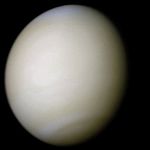
Exploration Past and current- Venus spacecraft
- Artificial objects on Venus
- Venera program
- Vega program
- Pioneer Venus
- Magellan
FutureAstronomy Other topics Spacecraft missions to Venus Flybys 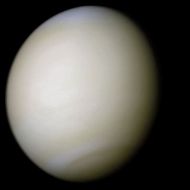
Orbiters Descent probes Landers Balloon probes Future missions Proposed missions Venus In-Situ Explorer (study)See also Bold italics indicates active missionsCategories:- Venus
- Terrestrial planets
Wikimedia Foundation. 2010.

